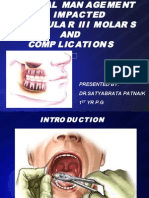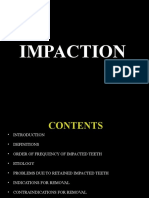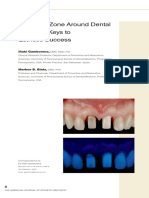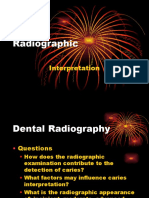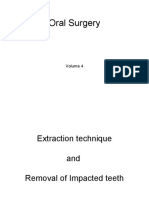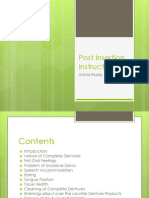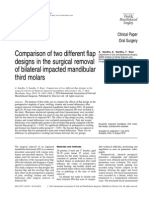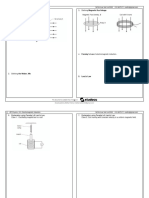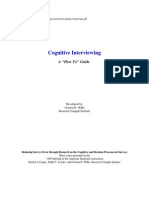Management of Odontogenic Infections and Sepsis
Management of Odontogenic Infections and Sepsis
Uploaded by
martha carolina vargas bernalCopyright:
Available Formats
Management of Odontogenic Infections and Sepsis
Management of Odontogenic Infections and Sepsis
Uploaded by
martha carolina vargas bernalOriginal Title
Copyright
Available Formats
Share this document
Did you find this document useful?
Is this content inappropriate?
Copyright:
Available Formats
Management of Odontogenic Infections and Sepsis
Management of Odontogenic Infections and Sepsis
Uploaded by
martha carolina vargas bernalCopyright:
Available Formats
VERIFIABLE CPD PAPER
Medical emergencies CLINICAL
Management of odontogenic infections and sepsis:
an update
Phil Jevon,*1 Ahmed Abdelrahman2 and Nick Pigadas3
Key points
Provides overview of management of Discusses recognition and management of sepsis in Considers sepsis in light of the COVID-19
odontogenic infection. the dental practice. pandemic.
Abstract
The management of odontogenic infections has improved over recent decades, but further improvements are still
required. The ongoing education of GDPs and their dental teams on this issue continues to be important, especially
during the current COVID-19 pandemic, where remote triage poses additional difficulties and challenges.
Odontogenic infections can lead to sepsis, a potentially life-threatening condition caused by the body’s immune
system responding in an abnormal way. This can lead to tissue damage, organ failure and death. A patient with
non-odontogenic-related infection could also present with sepsis at a dental practice. Early recognition and prompt
management of sepsis improves outcomes. GDPs and their dental teams should be trained in the recognition and
management of sepsis. Age-specific sepsis decision support tools have been developed by the UK Sepsis Trust to help
dental staff recognise and manage patients with suspected sepsis.
The aim of this article is to provide an update on the management of odontogenic infections and sepsis.
Introduction Early recognition and prompt effective • Stage 1: 1–3 days; soft and mildly tender
treatment of sepsis improves outcomes. 5 swelling
Although the management of odontogenic The dental team should be trained in the • Stage 2: 2–5 days; hard, red and severely
infections has improved over recent decades, principles of the management of sepsis.6 Age- sore swelling
further improvements are needed and the specific sepsis decision support tools have been • Stage 3: 5–7 days; abscess formation.
ongoing education of GDPs and their dental developed by the UK Sepsis Trust 7 to assist the
teams on this issue is essential. In addition, dental team to recognise and manage patients There is a strong belief that once the abscess
the COVID-19 pandemic has imposed new with suspected sepsis. has formed, surgical drainage is mandatory to
difficulties and challenges; for example, The aim of this article is to provide an update achieve resolution.12 Medical management has
telephone triage and prescription of antibiotics, on the management of odontogenic infections a role in selected cases.13
and it is important to be up-to-date with and sepsis in the dental practice.
current guidelines.1,2 Principles of effective management
Odontogenic infections can lead to sepsis,3,4 Management of odontogenic of odontogenic infections
a potentially life-threatening condition caused infections
by the body’s immune system responding Seven principles have been proposed to achieve
abnormally. This can lead to tissue damage, The morbidity and mortality rate of the best outcome in managing odontogenic
organ failure and death.5 A patient with non- odontogenic infections has dropped infections:11
odontogenic-related infection could also significantly over the past 70 years.8,9,10 This 1. Establish the severity of the infection
present with sepsis at a dental practice. dramatic drop is undoubtedly linked to the 2. Assess host defences
discovery of antibiotics, the improvement of 3. Elect the setting of care
1
Academy Tutor, Medical Education, Manor Hospital
the general population health standards, and 4. Surgical intervention
Walsall, UK; 2OMFS Speciality Trainee, Manor Hospital a better understanding of appropriate medical 5. Medical support
Walsall, UK; 3Consultant Maxillofacial/Head and Neck
Surgeon, Manor Hospital Walsall, UK.
and surgical management of these cases. 6. Antibiotic therapy
*Correspondence to: Phil Jevon Further improvements are needed and 7. Frequently evaluate the patient.
Email address: phil.jevon@walsallhealthcare.nhs.uk
ongoing education of the dental team on this
Refereed Paper. issue is very important. Establish the severity of infection
Accepted 27 May 2020 Odontogenic infections pass through three A careful history and thorough clinical
https://doi.org/10.1038/s41415-020-2114-5
key stages:11 examinations are essential to determine the
BRITISH DENTAL JOURNAL | VOLUME 229 NO. 6 | September 25 2020 363
© The Author(s), under exclusive licence to British Dental Association 2020
CLINICAL Medical emergencies
severity of any infection. History-taking
Table 1 Risks associated with anatomical location
will highlight factors like immune system
competence and the level of systemic Risk Low Moderate High Extreme
reserves to fight infections. A physical
Vestibular Submandibular Lateral pharyngeal Mediastinum
examination can identify clinical observations
outside normal limits. Several clinical and Infraorbital Submental Retropharyngeal Intracranial infection
haematological parameters have been used Buccal Sublingual Pretracheal
as prognostic indicators for the severity of Spaces
Pterygomandibular
the infection. C-reactive protein (CRP),
fever and anatomical locations have been Submasseteric
investigated for the assessment of the extent of Temporal
odontogenic infections and presumed duration
of hospital stay.14
Additional factors must be considered to Box 1 Factors that can compromise the immune system
establish the infection severity: • Diabetes steroid therapy
• Anatomical location • Organ transplants
• Airway compromise. • Malignancy
• Chemotherapy
There are a number of potential spaces • Chronic renal disease malnutrition
between the musculoskeletal head and neck • Alcoholism.
structures and the regional fasciae and organs
better known as fascial spaces. A summary of
these spaces and their level of risk11,12 is found management usually includes positioning the need for clear secondary care referral
in Table 1. the patient in an upright position and criteria. Although there are no agreed national
In healthy and systemically well patients administering oxygen 15 litres/minute, 15 guidelines on when to admit to a secondary
without trismus, infections of low-risk spaces while colleagues call 999 for an ambulance. care setting, criteria for hospital admission
can be initially treated in a primary care have been proposed2,20 (Box 2).
dental practice, while infections spreading to Assess host defences A careful history, thorough clinical
higher risk spaces should be managed more A healthy immune system is essential to the examinations and a high index of suspicion
aggressively and may need to be treated in a maintenance of host defence against infection. will enable the GDP to diagnose and
secondary care centre. Multiple medical conditions can affect it.17 Box appropriately manage patients presenting with
1 summarises the common factors that can odontogenic sepsis.
Ludwig’s angina cause immune system compromise.
Ludwig’s angina was described by Karl Friedrich The concept of ‘physiologic reserve’ Surgical intervention
Wilhelm von Ludwig in 1836 as a rapidly represents a significant driver of outcome in Early surgical intervention has been advocated
and frequently fatal progressive gangrenous patients fighting infection. This can be defined to improve the clinical outcome of odontogenic
cellulitis and ooedema of the soft tissues of as the capability of an organ to carry out its infection. The dramatic improvement in the
the neck and floor of the mouth.15 Thankfully, activity under stress.18 Age is an essential factor outcome of sever odontogenic infection is
mortality rates have reduced significantly that is inversely related to the physiologic directly linked to the immediate establishment
with the introduction of antibiotics, improved reserve; that is, decreased respiratory, of a safe airway, followed by early surgical
oral and dental hygiene, and timely surgical cardiovascular and metabolic reserve.19 intervention.
intervention.15 The majority of Ludwig’s angina Once the airway has been deemed patent
infections are odontogenic;16 peritonsillar Elect the setting of care and not at risk of being compromised, in
or parapharyngeal abscesses, mandibular An uncomplicated localised dental abscess in either a hospital setting or dental practice, the
fractures, oral lacerations/piercing and a healthy young person, who does not show principles of management are very similar.
submandibular sialoadenitis are other signs and symptoms of a worsening immune Thorough knowledge of head and neck
recognised causes.15 response, can be safely treated in a dental anatomy will enable the surgeon to access
A compromised airway is synonymous with practice. Early and adequate intervention the abscess cavities using incisions in safe
Ludwig’s angina and the initial assessment is essential in order to prevent avoidable places without damaging any vital structures
of a patient with Ludwig’s angina should deterioration with invasion of adjusted like blood vessels or nerves. Most of the
follow the familiar ‘Airway, Breathing, anatomical spaces and symptoms of sepsis odontogenic infections can be drained through
Circulation, Disability, Exposure’ (ABCDE) (Fig. 1). intraoral access.
approach. Signs of a compromised airway Similarly, severe neck infection in an Five principles must be followed:11,12
in these patients could include noisy immunocompromised elderly person warrants • Elimination of the source of the infection.
(gurgling) breathing with drooling saliva, treatment in a secondary care setting. The This can be achieved by either removing
stridor, dyspnoea, tachypnoea, tachycardia, clinical decision to choose the setting of care is the tooth or commencing root canal
dysphagia and trismus. The initial immediate not always straightforward though, prompting treatment
364 BRITISH DENTAL JOURNAL | VOLUME 229 NO. 6 | September 25 2020
© The Author(s), under exclusive licence to British Dental Association 2020
Medical emergencies CLINICAL
• Incisions to be made on healthy skin
or mucosa
• Blunt dissection to explore the abscess
cavity without damaging vital structures
A microbiology swab should be obtained
• Copious irrigations will ensure the dilution
of the bacterial load
• Drainage is maintained by placement of a
drain to keep the abscess cavity open.
Blunt dissection is achieved by inserting a
closed haemostat, then open it at a depth of
penetration and remove the instrument while
it is still open. A haemostat should never be
closed while it is inside the wound. Different
surgical drains are available to use and should
be removed when the drainage ceases, usually
between 48–72 hours.21
Although abscess formation takes place
between the fifth and seventh days, early
elimination of the infection source and surgical
intervention will decompress the involved
anatomical spaces.14 Relying on antibiotics only
in relieving dental infection is likely to be less
effective and can cause antimicrobial resistance.22
Two of the challenges to performing
adequate drainage of any odontogenic
infection in dental practice are:23
1. Achieving adequate local anaesthesia
Fig. 1 a) Even a mild pericoronitis b) if left untreated may progress to the formation of an abscess 2. Risk of spreading the infection to other
that could expand in the submandibular and submental spaces c) or further to the neck and anatomical spaces.
pretracheal spaces d) requiring extensive drainage and airway protection though a tracheostomy
The ability to deliver safe, adequate
local anaesthesia is essential for any dental
Box 2 Criteria for referral to secondary care2,20 procedure. The mechanism of action of the
• Difficulty in swallowing and dehydration
local anaesthetic solution depends on the
• Threat to the airway or vital structures
tissue pH. In the presence of infection, tissue
• Infection in moderate- or high-severity anatomic spaces
pH becomes more acidic, which slows down
• Involvement of orbital contents
the degree of ionisation, resulting in less
• Need for general anaesthesia
optimal or failed anaesthesia.23
• Need for inpatient control of systemic disease.
To overcome this problem, the injection of
the anaesthetic solution at a distance from the
Table 2 Recommended antibiotics and doses1,28 inflammatory site is required (nerve blocks).
It will also avoid infection spread to different
Issue to treat Antibiotic dose
tissue spaces.
Amoxicillin 500 mg TDS for five days (the dose can be
doubled in severe infection) Medical support
Phenoxymethylpenicillin 500 mg QDS for five days (the Although surgical drainage is the classic
First-line antibiotics for dental abscess in dental
dose can be doubled in severe infection) approach to most of the odontogenic
practices (adults and children more than 12 years)
Metronidazole 400 mg TDS should be used as an infection, medical support has a critical role in
alternative if the patient is allergic to penicillin or as controlling the disease.24 Adequate hydration,
adjunct to the above antibiotics in spreading infection nutrition and control of fever are essential
Clindamycin 150 mg QDS for five days to optimise the medical care for patients
Second-line antibiotics for dental abscess presenting with odontogenic infections.
(if a patient has not responded to the first-line Co-amoxiclav 375 mg TDS for five days
treatment)
Stabilisation of any underlying systemic
Clarithromycin 250 mg BD for five days disease (for example, uncontrolled diabetes)
is extremely important.24
BRITISH DENTAL JOURNAL | VOLUME 229 NO. 6 | September 25 2020 365
© The Author(s), under exclusive licence to British Dental Association 2020
CLINICAL Medical emergencies
Antibiotic therapy
Fig. 2 ‘Triage of commonly presenting dental problems’ from Management of acute dental
Odontogenic infections are multi-microbial problems during COVID-19 pandemic,1 reproduced with kind permission from the SDCEP
with a combination of facultative and anaerobes
species. Facultative Streptococcus viridans
Is there swelling?
group are commensal Gram-positive bacteria
and include S. anginosus, S. intermedius and S. YES NO
constellatus. These organisms are abundant in
the mouth and most frequently associated with
Does swelling restrict 1. Is patient in pain?
orofacial cellulitis and abscess. After a few days, swallowing or extend to or
the anaerobes (Prevotella and Porphyromonas) the eye? 2. Has patient suffered trauma to the teeth?
predominate. The majority of the facultative or
YES NO
3. Is there bleeding following an extraction?
streptococci that cause odontogenic infections
are sensitive to penicillin.25 Approximately YES NO
a quarter of strains of Prevotella and
Porphyromonas are penicillin-resistant.26 Provide self-help advice on:
The Scottish Dental Clinical Effectiveness 1. pain relief (check previous analgesic use) and
Programme (SDCEP) has published evidence- possible antibiotics for swelling due to infection
or
based guidance on antibiotic prescription in
2. dental trauma
dental practice. Penicillin-based antibiotics or
remain the first line for the treatment of 3. post-extraction bleeding
odontogenic infections. Metronidazole is
effective against anaerobic bacteria.1,27,28
If pain is severe and If mild or moderate
The antibiotic doses recommended in
uncontrolled*, pain or swelling
the SDCEP’s guidance are based on the If bleeding is or or
doses recommended by the British National uncontrolled spreading, recurrent or minor dental
Formulary (BNF)13 (Table 2). continuing infection trauma, including
or exposed dentine or
In secondary care settings, the antibiotics avulsed permanent tooth avulsed primary
are prescribed in accordance with the local or tooth
hospital antimicrobial therapy. Consultation severe trauma
with the on-call microbiologist is a common
practice for severe cases and cases which are
Advice &
not responding to first-line treatment. EMERGENCY Designated
Self Help
Care Urgent Dental
Care Centre General dental
Frequently evaluate the patient Via A&E or
practice, by
NHS24/111 As determined locally
The last principle, but as vital as the telephone
previous ones, is the periodic re-evaluation
of these patients. In outpatient settings, the
*Severe and uncontrolled pain is pain that cannot be controlled by the patient following self-help advice
recommended follow-up is after two days.29
Forty-eight hours will allow the drainage to
cease and the immune system to overcome secondary to inadequate drainage, wrong using remote consultation (telephone call or
the initial insult from the infection. If no antibiotic choice or incorrect dose. video call).1
improvement or deterioration of symptoms While assessing the patient, COVID-19
is noted, further escalation in care must be In hospital settings, more frequent status should be established and documented,
provided. The review interval, however, evaluations are essential as the disease is as this will determine how the patient’s
depends on the clinical course of the infection. expected to be more aggressive. care will be managed should referral to an
A patient with a rapidly developing swelling urgent dental care centre or secondary care
and mild temperature may need review Management of odontogenic be required. Patients should be advised that
within 24 hours, but a patient with a chronic infections during the COVID-19 dental treatment options are currently severely
abscess and no systemic symptoms will need pandemic restricted and that they should call back
to be reviewed at the end of the antibiotic in 48–72 hours if their symptoms have not
treatment. The COVID-19 pandemic has dramatically resolved.2
Causes of treatment failure include: changed dental practice since March 2020. The SDCEP’s flowchart (Fig. 2) helps the
• Failure to remove the source of infection Guidance on the management of acute dental remote management of patients by guiding
• Underlying systemic disease; for example, problems is available.2,30 This is likely to change the GDP to categorise the patient into one of
uncontrolled diabetes as the situation evolves. Advice, analgesia and three management groups.2
• Antibiotic-related factors – patient antimicrobials (when indicated) should form The SDCEP has also recently updated their
non-compliance, drug not reaching site the basis of primary care dental triage when Drugs for the management of dental problems
366 BRITISH DENTAL JOURNAL | VOLUME 229 NO. 6 | September 25 2020
© The Author(s), under exclusive licence to British Dental Association 2020
Medical emergencies CLINICAL
• Antibiotics are not indicated in the absence
Box 3 Sources of sepsis infection (approximate percentages)5 of swelling or other signs of infection
• Pneumonia: 50%
• The need to establish the patient’s self-
• Urinary tract: 20%
management to date and to check whether
• Abdomen: 15%
the patient may have overdosed, particularly
• Skin, soft tissue, bone and joint: 10%
with paracetamol
• Endocarditis: 1%
• The importance of checking with local
• Device-related infection: 1%
pharmacies that the drugs being prescribed
• Meningitis: 1%
are actually in stock
• Others: 2%.
• There is currently insufficient evidence
linking the use of ibuprofen or other
NSAIDs with contracting or worsening
of COVID-19 and, as such, they should
continue to be prescribed if indicated,
regardless of the patient’s COVID-19 status.
Worryingly, there has been a rise in
anecdotal reports of antibiotics apparently
being overprescribed for dental pain since
the outbreak of COVID-19.31 This pandemic
has demonstrated the havoc a pathogen can
unleash when we have no protection against
it. Inappropriate use of antibiotics increases the
likelihood that resistant bacteria will evolve31
and it is essential that GDPs remain guardians
against antimicrobial resistance.1,32 Antibiotics
should only be prescribed if it is likely that
the patient has a bacterial infection, and the
principles of prescribing and follow-up (as
detailed earlier) should be followed.
Management of sepsis: background
Incidence of sepsis
It is estimated that 234,000 patients develop
sepsis in the UK every year,5 with 70% of sepsis
cases originating in the primary care setting.
Annually, there are approximately 44,000
deaths from sepsis in the UK5 and six million
deaths worldwide.33 Although deaths from
sepsis due to odontogenic infection are very
rare, they have been reported.34
The incidence of sepsis is on the increase,
possibly due to:35
• A growing elderly population
• An increased use of invasive surgery
• An increased incidence of bacterial
resistance
Fig. 3 GDP sepsis decision support tool for primary dental care should be applied to all adults • An increased number of
and young people aged 12 years and over with fever (or recent fever), symptoms presenting
immunocompromised patients.
with a source of orofacial/dental infection (including post-operative infection) or have clinical
observations outside normal limits, reproduced with kind permission from the UK Sepsis Trust5
Causes of sepsis
A localised infection which progresses into
during COVID-19 pandemic guidance. This 1
including antibiotics, which GDPs are most an uncontrolled systemic response is usually
guidance supplements their Management likely to remotely advise or prescribe for their the cause of sepsis. Progression to acute
of acute dental problems during COVID- patients during the COVID-19 pandemic and physiological deterioration with the risk of
19 pandemic document.2 It lists the drugs, emphasises the following: multiple organ failure and death can be swift.
BRITISH DENTAL JOURNAL | VOLUME 229 NO. 6 | September 25 2020 367
© The Author(s), under exclusive licence to British Dental Association 2020
CLINICAL Medical emergencies
In normal circumstances, the body’s immune
system will prevent or fight infection (bacteria,
viruses, fungi). However, the immune system can
sometimes go into overdrive, resulting in vital
organs and other tissues being targeted. This can
result from any injury or infection in the body.
Although a wide variety of different
microorganisms (for example, Streptococcus, E.
coli, MRSA or Clostridium difficile) can cause
sepsis, it is usually caused by common bacteria
that don’t normally make patients ill.36
Any infection can lead to sepsis (Box 3),
though pneumonia (commonly referred to as
chest sepsis) is the cause in half of the cases.5
Risk factors for developing sepsis
The National Institute for Health and Care
Excellence (NICE) 6 has highlighted the
following risk factors for sepsis:
• Children under one year of age and people
>75 years old
• Frailty
• Impaired immune systems because of
illness or drugs, including patients:
º On chemotherapy for cancer
º Taking long-term steroids
º Taking immunosuppressant drugs to
treat non-malignant disorders such as
rheumatoid arthritis
º With an impaired immune function;
for example, diabetics, previous
splenectomy and sickle cell disease
• Recent surgery, or other invasive
procedures, in the past six weeks
• Breach of skin integrity; for example, cuts,
burns, blisters or skin infections
• Intravenous drug users
• Existing indwelling venous line or urinary
Fig. 4 ‘GDP paediatric sepsis decision support tool for primary dental care’ should be applied
catheter
to all children aged between 5–11 years who have a suspected source of orofacial/dental
• Pregnancy and within six weeks following
infection (including post-operative infection) or have clinical observations outside the normal
birth, termination of pregnancy or range, reproduced with kind permission from the UK Sepsis Trust5
miscarriage.
Management of sepsis: sepsis The Care Quality Commission (CQC)38 limits.7 It details what to look out for if
decision support tools endorses these sepsis decision tools and, the patient has presumed infection and, in
ideally, all three should be readily available in particular, what constitutes Red Flag sepsis.
The UK Sepsis Trust has developed age-specific the dental practice.
sepsis decision support tools to assist the dental Red Flag sepsis
team to assess both adult and paediatric patients Sepsis decision tool for adults/young Red Flag sepsis is a definition from the
who may have sepsis.7 Utilisation of these people aged 12 years and over UK Sepsis Trust which lists a set of easy-
sepsis decision tools will help determine if Red The ‘GDP sepsis decision support tool for to-assess clinical parameters, the presence
Flag sepsis (see below) is present, prompting primary dental care’ (Fig. 3) should be applied of one of which in the context of infection
appropriate timely action. The prompt transfer to all adults and young people aged 12 years identifies sepsis with a high risk of death and
of patients presenting with orofacial infections and over with fever (or recent fever), symptoms a requirement for urgent treatment (Fig. 3).7
suspected of sepsis to an acute hospital setting presenting with a source of orofacial/dental If Red Flag sepsis is present:
for early treatment should ultimately improve infection (including post-operative infection) • Call 999 for an ambulance and state Red
sepsis survival rates.37 or have clinical observations outside normal Flag sepsis7
368 BRITISH DENTAL JOURNAL | VOLUME 229 NO. 6 | September 25 2020
© The Author(s), under exclusive licence to British Dental Association 2020
Medical emergencies CLINICAL
tools described here for safe management of such
patients. In addition, evidence suggests that, for
a period of time following sepsis, patients may
be vulnerable and develop further infections
including COVID-19; therefore, they have an
increased risk of readmission with infective
complications (including sepsis).5
The NICE and sepsis
The NICE advises that patients with suspected
sepsis are assessed following a structured set of
observations to stratify the risk of acute illness
or death.6 The Royal College of Physicians’
National Early Warning Score (NEWS) 2 is
widely used by the ambulance service and in
hospitals, and reliably detects deterioration
in adults, triggering review, treatment and
escalation of care, particularly sepsis. 41
Although NEWS2 hasn’t yet been validated
for use in primary care, NHS England is
encouraging its widespread use in this sector.42
The CQC and sepsis
The CQC has created a webpage titled
‘Dental mythbuster 25: sepsis’ on its website,38
providing helpful information relating to the
management of sepsis in the dental practice,
including online links to professional
guidelines (NICE and UK Sepsis Trust) as well
as what to expect from the CQC, relating to
sepsis, when they review dental practices to
determine whether they are safe and well-led.
When reviewing dental practices, the CQC
will ask dental staff what systems and processes
are in place to manage a patient with a bacterial
infection, including procedures for follow-up
Fig. 5 ‘GDP paediatric sepsis decision support tool for primary dental care’ should be applied
and referral for specialist care when necessary.
to all children aged <5 years who have a suspected source of orofacial/dental infection
This will include treating patients who:
(including post-operative infection) or have clinical observations outside the normal range,
reproduced with kind permission from the UK Sepsis Trust5 • Are not responding to conventional oral
antibiotic treatment
• Cannot have their infection drained at an
• Follow the ABCDE approach to assess and source of orofacial/dental infection (including initial appointment.
treat the acutely ill patient 39 post-operative infection) or have clinical
• Administer oxygen 15 litres/minute using observations outside the normal range.7 The The CQC will also ask what advice is given
a non-rebreather oxygen mask40 paediatric sepsis decision tools take into to patients, including when they should seek
• Print off the patient’s medical history and account paediatric considerations, including emergency advice or treatment, if symptoms
ensure effective communication to the differences in paediatric physiology. worsen or when the dental surgery is closed.
ambulance service (situation, background,
assessment, recommendation [SBAR]).41 COVID-19 and sepsis Conclusion
Paediatric sepsis decision tools COVID-19 infection can cause sepsis on its own.5 Odontogenic infections can lead to sepsis,
There are two paediatric sepsis decision tools, Unfortunately, the sepsis signs and symptoms which can result in tissue damage, organ
one for children aged 5–11 years (Fig. 4) and for a number of initial conditions can be very failure and death. This article has outlined
one for children <5 years (Fig. 5). These should similar. This stresses the importance for dental the management of odontogenic infections,
be used in children who have a suspected teams to be familiar with sepsis and the decision including the latest COVID-19 guidelines.
BRITISH DENTAL JOURNAL | VOLUME 229 NO. 6 | September 25 2020 369
© The Author(s), under exclusive licence to British Dental Association 2020
CLINICAL Medical emergencies
The recognition and management of 14. Fu B, McGowan K, Sun J H, Batstone M. Increasing 30. NHS England & NHS Improvement. COVID-19 guidance and
frequency and severity of odontogenic infection standard operating procedure. 2020. Available at https://
sepsis in the dental practice has also been requiring hospital admission and surgical www.england.nhs.uk/coronavirus/wp-content/uploads/
discussed, including the age-specific sepsis management. Br J Oral Maxillofac Surg 2020; 58: sites/52/2020/06/C0581-covid-19-urgent-dental-care-
409–415. sop-update-16-june-20-.pdf (accessed May 2020).
decision support tools developed by the UK 15. Saifeldeen K, Evans R. Ludwig’s angina. Emerg Med J 31. Sanderson S. Coronavirus: When to prescribe
Sepsis Trust. 2004; 21: 242–243. antibiotics. 2020. Available at https://bda.org/news-
16. Quinn F B. Ludwig’s angina. Arch Otolaryngol Head centre/blog/Pages/Coronavirus-When-to-prescribe-
Neck Surg 1999; 125: 599. antibiotics.aspx (accessed May 2020).
References 17. Gordon N C, Connelly S. Management of head and 32. Public Health England, Royal College of Surgeons,
neck infections in the immunocompromised patient. Faculty of General Dental Practice (UK) & BDA. Open
1. SDCEP. Drugs for the Management of Dental
Oral Maxillofac Surg Clin North Am 2003; 15: 103–110. letter on prescribing antibiotics during COVID-19. 2020.
Problems During COVID-19 Pandemic. 2020.
18. Atamna H, Tenore A, Lui F, Dhahbi J M. Organ Available at https://www.fgdp.org.uk/news/open-
Available at https://www.sdcep.org.uk/wp-content/
reserve, excess metabolic capacity, and aging. letter-prescribing-antibiotics-during-covid-19-%C2%A0
uploads/2020/05/SDCEP-MADP-COVID-19-drug-
Biogerontology 2018; 19: 171–184. (accessed May 2020).
supplement-update-110520.pdf (accessed May
19. El Chakhtoura N G, Bonomo R A, Jump R L P. 33. Fleischmann C, Scherag A, Adhikari N K et al. Assessment
2020).
Influence of Aging and Environment on Presentation of Global Incidence and Mortality of Hospital-treated
2. SDCEP. Management of Acute Dental Problems
of Infection in Older Adults. Infect Dis Clin North Sepsis. Current Estimates and Limitations. Am J Respir Crit
During COVID-19 Pandemic. 2020. Available
Am 2017; 31: 593–608. Care Med 2016; 193: 259–272.
at https://www.sdcep.org.uk/wp-content/
20. Alotaibi N, Cloutier L, Khaldoun E, Bois E, Chirat 34. Carter L, Lowis E Death from overwhelming
uploads/2020/03/SDCEP-MADP-COVID-19-
M, Salvan D. Criteria for admission of odontogenic odontogenic sepsis: a case report. Br Dent J 2007; 203:
guide-300320.pdf (accessed May 2020).
infections at high risk of deep neck space infection. 241–242.
3. Weise H, Naros A, Weise C et al. Severe odontogenic
Eur Ann Otorhinolaryngol Head Neck Dis 2015; 132: 35. Scottish Intensive Care Society. Sepsis. 2019. Available
infections with septic progress – a constant and
261–264. online at https://www.scottishintensivecare.org.uk/
increasing challenge: a retrospective analysis. BMC
21. Bouloux G F, Wallace J, Xue W. Irrigating drains training-education/sics-induction-modules/sepsis/
Oral Health 2019; 19: 173.
for severe odontogenic infections do not improve (accessed May 2020).
4. Gilway D, Brown S J. Medical emergencies: Sepsis in
outcome. J Oral Maxillofac Surg 2013; 71: 42–46. 36. NHS England. Sepsis guidance implementation advice
primary dental care. Br Dent J 2016; 220: 278.
22. Flynn T R, Halpern L R. Antibiotic selection in head for adults. 2017. Available at https://www.england.
5. UK Sepsis Trust. Professional resources. 2020.
and neck infections. Oral Maxillofacial Surg Clin North nhs.uk/wp-content/uploads/2017/09/sepsis-guidance-
Available online at https://sepsistrust.org/
Am 2003; 15: 17–38. implementation-advice-for-adults.pdf (accessed May
professional-resources/ (accessed May 2020).
23. Giovannitti Jr J A, Rosenberg M.B, Phero J C. 2020).
6. NICE. Sepsis: recognition, diagnosis and early
Pharmacology of Local Anaesthetics Used in Oral 37. Kaur H, Anstey H, Taylor G, Daniels R. Sepsis
management NICE guideline. 2017. Available
Surgery. Oral Maxillofacial Surg Clin North Am 2013; Decision Support Tool for Primary Dental Care. FDJ
at https://www.nice.org.uk/guidance/ng51/
25: 453–465. 2019; 10: 142–146. Available online at https://
resources/sepsis-recognition-diagnosis-and-early-
24. Mayor G, Millan J, Martinez-Vidal A. Is conservative publishing.rcseng.ac.uk/doi/abs/10.1308/
management-1837508256709 (accessed May 2020).
treatment of deep neck space infections appropriate? rcsfdj.2019.142?journalCode=fdj (accessed August
7. UK Sepsis Trust. Clinical Tools. 2020. Available online
Head Neck 2001; 23: 126–133. 2020).
at https://sepsistrust.org/professional-resources/
25. Chunduri N S, Madasu K, Goteki V R, Karpe T, Reddy 38. Care Quality Commission. Dental mythbuster 25: Sepsis.
clinical-tools/ (accessed May 2020).
H. Evaluation of bacterial spectrum of orofacial 2019. Available at https://www.cqc.org.uk/guidance-
8. Har-El G, Aroesty J H, Shaha A, Lucente F E. Changing
infections and their antibiotic susceptibility. Ann providers/dentists/dental-mythbuster-25-sepsis
trends in deep neck abscess. A retrospective study
Maxillofac Surg 2012; 2: 46–50. (accessed May 2020).
of 110 patients. Oral Surg Oral Med Oral Pathol 1994;
26. Flynn T R, Shanti R M, Hayes C. Severe odontogenic 39. Resuscitation Council UK. The ABCDE Approach.
77: 446–450.
infections. Part 2. Prospective outcomes study. J Oral 2020. Available online at https://www.resus.org.uk/
9. Sethi D S, Stanley R E. Deep neck abscesses –
Maxillofac Surg 2006; 64: 1104–1113. library/2015-resuscitation-guidelines/abcde-approach
changing trends. J Laryngol Otol 1994; 108: 138–143.
27. SDCEP. Management of Acute Dental Problems: (accessed May 2020).
10. Amponsah E, Donkor P. Life-threatening oro-facial
Guidance for healthcare professionals. 2013. 40. Jevon P. Basic Guide to Medical Emergencies in the Dental
infections. Ghana Med J 2007; 41: 33–36.
Available at https://www.sdcep.org.uk/wp-content/ Practice: Second Edition. Oxford: Wiley Blackwell, 2014.
11. Flynn T. Principles of management of odontogenic
uploads/2013/03/SDCEP+MADP+Guidance+ 41. Royal College of Physicians. National Early Warning
infections. In Miloro M, Ghali G E, Larsen P, Waite
March+2013.pdf (accessed May 2020). Score (NEWS) 2: Standardising the assessment of
P (eds) Peterson’s principles of oral and maxillofacial
28. SDCEP. Drug prescribing for dentistry: dental clinical acute-illness severity in the NHS. 2017. Available online
surgery. 3rd ed. Beijing: PMPH, 2012.
guidance (third edition). 2016. Available at https:// at https://www.rcplondon.ac.uk/projects/outputs/
12. Osborn T, Assael LA, Bell R B. Deep space neck
www.sdcep.org.uk/wp-content/uploads/2016/03/ national-early-warning-score-news-2 (accessed August
infection: principles of surgical management. Oral
SDCEP-Drug-Prescribing-for-Dentistry-3rd-edition. 2020).
Maxillofac Surg Clin North Am 2008; 20: 353–365.
pdf (accessed May 2020). 42. NHS England. National Early Warning Score
13. NICE/BNF. Prescribing in Dental Practice. 2020.
29. Vieira F, Allen S M, Stocks R M S, Thompson J W. (NEWS). 2017. Available at https://www.
Available at https://bnf.nice.org.uk/guidance/
Deep Neck Infection. Otolaryngol Clin North Am 2008; england.nhs.uk/ourwork/clinical-policy/sepsis/
prescribing-in-dental-practice.html (accessed May
41: 459–483. nationalearlywarningscore/ (accessed May 2020).
2020).
370 BRITISH DENTAL JOURNAL | VOLUME 229 NO. 6 | September 25 2020
© The Author(s), under exclusive licence to British Dental Association 2020
You might also like
- Implant Prosthodontics: Protocols and Techniques for Fixed Implant RestorationsFrom EverandImplant Prosthodontics: Protocols and Techniques for Fixed Implant RestorationsNo ratings yet
- Standard of Care in DentistryDocument8 pagesStandard of Care in DentistryKavitha P. DasNo ratings yet
- Surgical Management of Impacted ToothDocument71 pagesSurgical Management of Impacted ToothAntony Sebastian100% (2)
- Glossary of Periodontal Terms PDFDocument56 pagesGlossary of Periodontal Terms PDFCarlos Gilberto Guillaumin EsparzaNo ratings yet
- EZdok CAMERA ADDON Advanced Effects ManualDocument24 pagesEZdok CAMERA ADDON Advanced Effects ManualOwneatorNo ratings yet
- Inadvertent Tooth Movement With Fixed Lingual Retainers: Clinician'S CornerDocument10 pagesInadvertent Tooth Movement With Fixed Lingual Retainers: Clinician'S CornercempapiNo ratings yet
- Risk AssessmentDocument101 pagesRisk Assessmentrevu dasNo ratings yet
- ImpactionDocument167 pagesImpactionAME DENTAL COLLEGE RAICHUR, KARNATAKA100% (1)
- Complications of Teeth ExtractionsDocument62 pagesComplications of Teeth ExtractionsIrfan AliNo ratings yet
- Esthetic Management of Space and Soft Tissue Deficiencies in Implant Therapy Combined Orthodontic-Mucogingival ApproachDocument16 pagesEsthetic Management of Space and Soft Tissue Deficiencies in Implant Therapy Combined Orthodontic-Mucogingival Approachfloressam2000No ratings yet
- The Gray Zone Around Dental Implants - Keys To Esthetic SuccessDocument20 pagesThe Gray Zone Around Dental Implants - Keys To Esthetic SuccessZardasht NajmadineNo ratings yet
- Vital Therapy in Carious ToothDocument9 pagesVital Therapy in Carious ToothAsh PeiNo ratings yet
- Impaction: BY T.Subba Raju Iind Year Post GraduateDocument63 pagesImpaction: BY T.Subba Raju Iind Year Post GraduateJoseph Parasa100% (1)
- Controversiesin Anesthesiafororaland Maxillofacialsurgery: Brett J. King,, Adam LevineDocument9 pagesControversiesin Anesthesiafororaland Maxillofacialsurgery: Brett J. King,, Adam LevineAB MISHRANo ratings yet
- Prosthetic SurgeryDocument14 pagesProsthetic SurgeryCristina CArrera100% (1)
- Tarrson Family Endowed Chair in PeriodonticsDocument54 pagesTarrson Family Endowed Chair in PeriodonticsAchyutSinhaNo ratings yet
- Diogenes2017.PDF Regenerative EndoDocument15 pagesDiogenes2017.PDF Regenerative Endodrmezzo68No ratings yet
- Radiographic InterpretationDocument46 pagesRadiographic InterpretationSanaFatimaNo ratings yet
- Manejo de Terceros Molares - Rafetto 2015Document9 pagesManejo de Terceros Molares - Rafetto 2015Hugo HerreraNo ratings yet
- Healing of Extraction SocketDocument21 pagesHealing of Extraction SocketSushant Pandey100% (1)
- Pulpitis: A ReviewDocument6 pagesPulpitis: A ReviewIOSRjournalNo ratings yet
- Pickard's Manual-Tooth Wear (Dragged)Document8 pagesPickard's Manual-Tooth Wear (Dragged)Adit MehtaNo ratings yet
- Mouth Preparation For Removable Dental ProsthesisDocument64 pagesMouth Preparation For Removable Dental Prosthesismujtaba100% (1)
- Dental Implants Are Contraindicated In...Document5 pagesDental Implants Are Contraindicated In...Lia DietrichNo ratings yet
- 2 Nonsurgical Periodontal Therapy - Pocket DentistryDocument14 pages2 Nonsurgical Periodontal Therapy - Pocket DentistryRizki OktavianiNo ratings yet
- Atraumatic Tooth ExtractionDocument10 pagesAtraumatic Tooth ExtractionAnderson AraujoNo ratings yet
- Cracked Tooth SyndromDocument19 pagesCracked Tooth SyndromNUHA ELKADIKINo ratings yet
- GingivectomyDocument5 pagesGingivectomyRomzi HanifNo ratings yet
- Implant-Related Complications and FailuresDocument91 pagesImplant-Related Complications and FailuresSaman MohammadzadehNo ratings yet
- Topicalhemostatic Agents: What The Oral and Maxillofacial Surgeon Needs To KnowDocument10 pagesTopicalhemostatic Agents: What The Oral and Maxillofacial Surgeon Needs To KnowAB MISHRANo ratings yet
- 0 - A Clinical Guide To OcclusionDocument1 page0 - A Clinical Guide To Occlusionyhajo100% (1)
- Pre-And Postoperative Management Techniques. Before and After. Part 1: Medical MorbiditiesDocument6 pagesPre-And Postoperative Management Techniques. Before and After. Part 1: Medical MorbiditiesMostafa FayadNo ratings yet
- Endodontic TT OutcomesDocument22 pagesEndodontic TT OutcomesritikaNo ratings yet
- Oral Surgery Volume 4, Extraction and Impacted TeethDocument32 pagesOral Surgery Volume 4, Extraction and Impacted TeethskyangkorNo ratings yet
- Oral and Dental HistologyDocument6 pagesOral and Dental HistologyCésar HelenoNo ratings yet
- Treatment Options For Missing Teeth PDFDocument7 pagesTreatment Options For Missing Teeth PDFNajeeb UllahNo ratings yet
- Post Insertion InstructionsDocument23 pagesPost Insertion InstructionsAnkita Reddy VallapNo ratings yet
- Dent Update 2013. Guidelines For The Assessment of The Impacted Maxillary CanineDocument6 pagesDent Update 2013. Guidelines For The Assessment of The Impacted Maxillary CanineWayan Sutresna Yasa100% (1)
- Basic Surgical Principles With ITI ImplantsDocument10 pagesBasic Surgical Principles With ITI ImplantsEliza DN100% (1)
- Complications of Exodontics: Mary Cris P EstandarteDocument49 pagesComplications of Exodontics: Mary Cris P EstandarteRealyn D. BerderaNo ratings yet
- Working Length Determination in RCTDocument38 pagesWorking Length Determination in RCTDidar Sadiq Kwekha100% (1)
- Flap Design 3rd MolarDocument6 pagesFlap Design 3rd MolarArindam DuttaNo ratings yet
- Surgical Complications in Oral Implantology: Etiology, Prevention, and ManagementFrom EverandSurgical Complications in Oral Implantology: Etiology, Prevention, and ManagementNo ratings yet
- Biologic WidthDocument26 pagesBiologic Widthbhasalepooja67% (3)
- HYPERTENSIONDocument55 pagesHYPERTENSIONCut Putri RiskaNo ratings yet
- Introduction of Removable Partial Denture - Design and RetentionDocument72 pagesIntroduction of Removable Partial Denture - Design and RetentionDilesh Pradhan0% (1)
- Restoration Made Possible With Forced OrthodonticDocument3 pagesRestoration Made Possible With Forced OrthodonticLaura RuZe100% (1)
- 3rd Molar ImpactionDocument31 pages3rd Molar ImpactionPuneet Jain100% (2)
- Diagnosis of Partially Edentulous PatientDocument82 pagesDiagnosis of Partially Edentulous PatientMostafa Fayad0% (1)
- Adhesion, Layering, and Finishing of Resin Composite Restorations For Class II Cavity PreparationsDocument12 pagesAdhesion, Layering, and Finishing of Resin Composite Restorations For Class II Cavity PreparationsPanchyRojasNo ratings yet
- Esthetics in DentistryDocument143 pagesEsthetics in DentistryPranshu TomerNo ratings yet
- Contemporary Endodontics - DNCADocument219 pagesContemporary Endodontics - DNCAARTNo ratings yet
- Removal of Impacted Third MolarDocument13 pagesRemoval of Impacted Third MolarHarkanNo ratings yet
- Risk Management Oral SurgeryDocument7 pagesRisk Management Oral SurgerymohsinosmaanNo ratings yet
- Management of Necrotizing Ulcerative Gingivitis in A Pregnant Patient - A Rare Case ReportDocument6 pagesManagement of Necrotizing Ulcerative Gingivitis in A Pregnant Patient - A Rare Case ReportAZWAN RAHMADHAN PUTRA100% (1)
- 3rd Molar Guidelines April 2021 v3Document110 pages3rd Molar Guidelines April 2021 v3aram meyedyNo ratings yet
- Tissue ManagementDocument16 pagesTissue ManagementSaleh AlsadiNo ratings yet
- Minimally Invasive Periodontal Therapy: Clinical Techniques and Visualization TechnologyFrom EverandMinimally Invasive Periodontal Therapy: Clinical Techniques and Visualization TechnologyNo ratings yet
- NATIONAL DENTAL BOARDS (NDB) / PART I: Passbooks Study GuideFrom EverandNATIONAL DENTAL BOARDS (NDB) / PART I: Passbooks Study GuideRating: 1 out of 5 stars1/5 (1)
- Basic Guide to Infection Prevention and Control in DentistryFrom EverandBasic Guide to Infection Prevention and Control in DentistryNo ratings yet
- Balaji Institute of Engineering & Management Studies Department of Mba (14E00208) Management Information System LabDocument23 pagesBalaji Institute of Engineering & Management Studies Department of Mba (14E00208) Management Information System Labchitra2010No ratings yet
- National Budget 2017Document256 pagesNational Budget 2017Kristi DuranNo ratings yet
- Autacoids: (Histamine, Serotonin, Eicosanoids, Kinins)Document31 pagesAutacoids: (Histamine, Serotonin, Eicosanoids, Kinins)Micah MonteNo ratings yet
- VectorsDocument13 pagesVectorsHemang MehtaNo ratings yet
- LTE Scope-Store ENT Service Manual (PIM20411)Document79 pagesLTE Scope-Store ENT Service Manual (PIM20411)Odie LeungNo ratings yet
- Effects of Trade Openness On Regional Economic GrowthDocument5 pagesEffects of Trade Openness On Regional Economic GrowthMOHD NOR HIDAYAT MELBINNo ratings yet
- Syllabus: Courses of StudyDocument24 pagesSyllabus: Courses of Studyabhishek singhNo ratings yet
- Design CalculationDocument56 pagesDesign Calculationjaslin100% (2)
- Magnetic InductionDocument29 pagesMagnetic Inductionmidhat.fatima180No ratings yet
- Millman Et Al 1965 An Analysis of Test WisenessDocument20 pagesMillman Et Al 1965 An Analysis of Test WisenessNikos PapanikolaouNo ratings yet
- Site PlanningDocument26 pagesSite PlanningNurul AfiqahNo ratings yet
- Transducers and Adapters: For Vanguard Circuit Breaker AnalyzersDocument12 pagesTransducers and Adapters: For Vanguard Circuit Breaker AnalyzersJuan Alberto Amaya HurtadoNo ratings yet
- Fundamental Shi'ite BeliefsDocument87 pagesFundamental Shi'ite BeliefsMehboob HassanNo ratings yet
- Assessment of Water Fowl Diversity of River Chenab, PakistanDocument7 pagesAssessment of Water Fowl Diversity of River Chenab, PakistanAdnan AhmedNo ratings yet
- 4TH 1STDocument1 page4TH 1STmartazemeduNo ratings yet
- Double CRAW: Basic Instructions English VersionDocument7 pagesDouble CRAW: Basic Instructions English VersionSv Beads100% (3)
- Operating Systems Concepts Chapter 1 QuestionsDocument7 pagesOperating Systems Concepts Chapter 1 QuestionsTyler ThrockmortonNo ratings yet
- Moyer Dawn J2000Document108 pagesMoyer Dawn J2000GayathriRajasekaranNo ratings yet
- Manual: LANTIME OS Version 6Document49 pagesManual: LANTIME OS Version 6Francisco Aguirre VarasNo ratings yet
- Igo Hatsuyōron 120 - An Elephant in SlicesDocument106 pagesIgo Hatsuyōron 120 - An Elephant in SlicesАндрей ИвановNo ratings yet
- Disertasi Niem Tu Huynh BAB 4Document41 pagesDisertasi Niem Tu Huynh BAB 4Nabila Aulia KarimahNo ratings yet
- Company Introduction Terra Global SalespartnersDocument17 pagesCompany Introduction Terra Global SalespartnersAlby MilesNo ratings yet
- Cognitive Interviewing: A "How To" GuideDocument41 pagesCognitive Interviewing: A "How To" Guidefrieda20093835No ratings yet
- Avoir in French Conjugation, Tenses & ExamplesDocument1 pageAvoir in French Conjugation, Tenses & Examplesgracebon26No ratings yet
- Preliminary English Test: Khoon Kyal SinDocument1 pagePreliminary English Test: Khoon Kyal SinkhoonNo ratings yet
- Department Orders SummaryDocument15 pagesDepartment Orders SummaryLowie Torres TonioNo ratings yet
- 80 - Sharma - THESIS - Design of Inlet For Boundary Layer Ingestion in A BWBDocument143 pages80 - Sharma - THESIS - Design of Inlet For Boundary Layer Ingestion in A BWBKevin SánchezNo ratings yet
- 路基路面典型横断面图 Cp6 Conceptual DesignDocument38 pages路基路面典型横断面图 Cp6 Conceptual DesignSudish amatyaNo ratings yet
- Ultimatix and Key TCS Apps OverviewDocument17 pagesUltimatix and Key TCS Apps OverviewJames100% (1)



